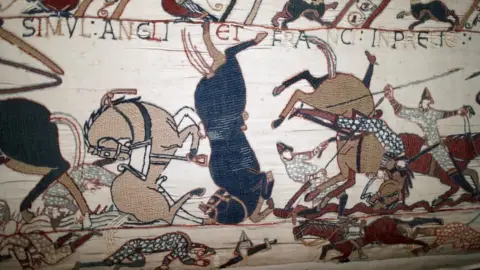The Bayeux Tapestry, which documents the Norman invasion of England in 1066, will be closed to the public in France from Monday as opposition mounts ahead of its move to London.
The next time it will be possible to see the nearly 1,000-year-old work of art should be when it goes on display at the British Museum in September next year.
However, the French art world is fiercely opposed to the project, with experts fearing the 70m-long (230ft) masterpiece is in far too delicate a state to be transported across the Channel.
French President Emmanuel Macron and Prime Minister Sir Keir Starmer announced the loan during their London meeting in July. The last few weeks have seen a significant rise in visitor numbers at the Bayeux Museum ahead of its closure.
A new display area for the tapestry is currently under construction, which will take at least two years to complete. Macron’s act of cultural diplomacy to loan the tapestry for a year from September has triggered an outcry from many in the French art world.
A petition, which describes the loan as a cultural crime, has collected over 60,000 signatures. Critics resent that Macron made this decision without fully considering the expert advice which warns that the vibrations from a long road journey could cause irreparable damage.
On 22 August, a French official defended the move, claiming the tapestry is not too fragile for transport. Philippe Bélaval stated that while no decision had been made regarding the transportation method, a study earlier this year outlined safe handling recommendations.
Cecile Binet, a regional museum adviser for Normandy, meanwhile emphasized that long-distance movement poses significant conservation risks, deeming the tapestry "too fragile."
This vibrant embroidery, believed to have originated in Kent, will be showcased in London until July 2027 in exchange for notable artefacts, including Anglo-Saxon treasures and the 12th Century Lewis chess pieces traveling to France.
Despite losing the final portion of the tapestry, which reflects the Anglo Saxons fleeing after the Battle of Hastings, its 58 scenes capture a unique historical insight into both military traditions and everyday life during the medieval period.



















